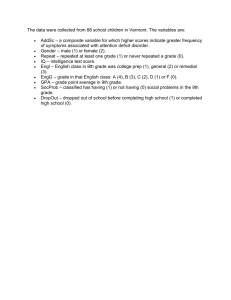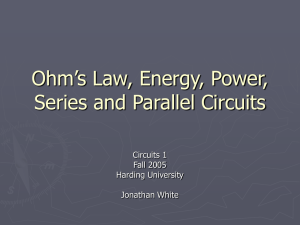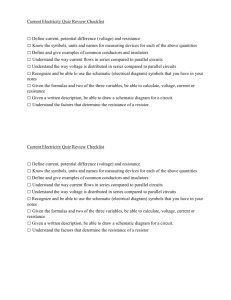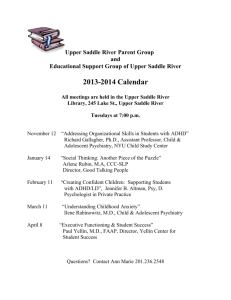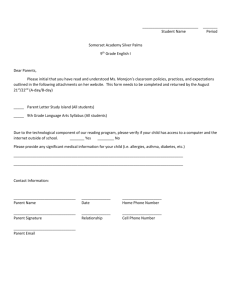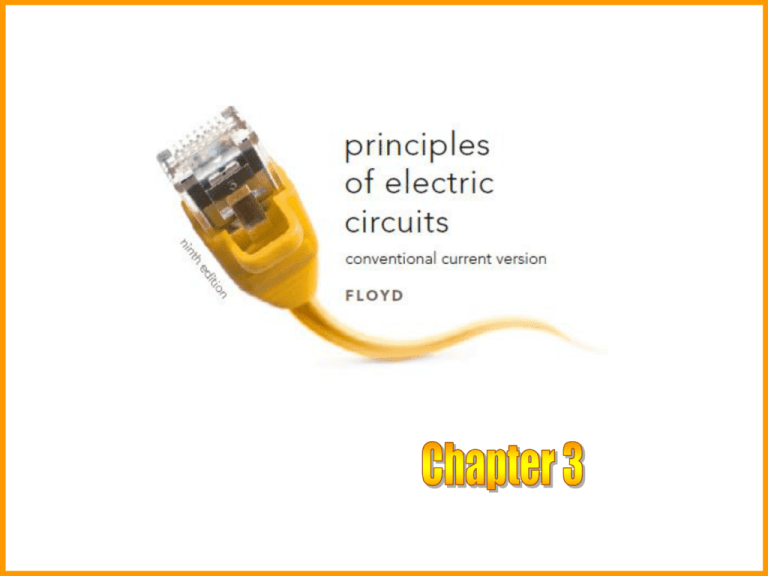
Chapter 3
Principles of Electric Circuits, Conventional Flow, 9th ed.
Floyd
© 2010 Pearson Higher Education,
Upper Saddle River, NJ 07458. • All Rights Reserved
Chapter 3
Review of V, I, and R
Voltage is the amount of energy per charge available to
move electrons from one point to another in a circuit.
Current is the rate of charge flow and is measured in
amperes.
Resistance is the opposition to current and is measured
in ohms.
Principles of Electric Circuits, Conventional Flow, 9th ed.
Floyd
© 2010 Pearson Higher Education,
Upper Saddle River, NJ 07458. • All Rights Reserved
Chapter 3
The most important fundamental law in electronics is
Ohm’s law, which relates voltage, current, and resistance.
Georg Simon Ohm (1787-1854) studied the relationship
between voltage, current, and resistance and formulated
the equation that bears his name. In terms of current,
Ohm’s law states
V
I
R
What is the current in from a 12 V source if the
resistance is 10 W? 1.2 A
Principles of Electric Circuits, Conventional Flow, 9th ed.
Floyd
© 2010 Pearson Higher Education,
Upper Saddle River, NJ 07458. • All Rights Reserved
Chapter 3
Ohm’s law
If you need to solve for voltage, Ohm’s law is:
V IR
What is the voltage across a 680 W resistor if the
current is 26.5 mA? 18 V
Principles of Electric Circuits, Conventional Flow, 9th ed.
Floyd
© 2010 Pearson Higher Education,
Upper Saddle River, NJ 07458. • All Rights Reserved
Chapter 3
Ohm’s law
V
If you need to solve for resistance, Ohm’s law is: R
I
What is the (hot)
resistance of the bulb? 138 W
OFF
V
Hz
120 V
V
mV
A
Range
Autorange
Touc h/Hold
1s
1s
10 A
V
40 mA
COM
Fused
Principles of Electric Circuits, Conventional Flow, 9th ed.
Floyd
© 2010 Pearson Higher Education,
Upper Saddle River, NJ 07458. • All Rights Reserved
Chapter 3
A student takes data for a resistor and fits the straight
ofthe
Current
versus
Voltage
lineGraph
shown to
data. What
is the
resistance and the
conductance of the resistor?
16
The slope represents the
conductance.
14.8 mA - 0 mA
1.48 mS
10.0 V - 0 V
The reciprocal of the
conductance is the
resistance:
R
1
1
676 Ω
G 1.48 mS
I (mA)
G
14
12
8
4
0
0
2
4
6
8
10
V (V)
Principles of Electric Circuits, Conventional Flow, 9th ed.
Floyd
© 2010 Pearson Higher Education,
Upper Saddle River, NJ 07458. • All Rights Reserved
Chapter 3
Graph of Current versus Voltage
Current (mA)
Notice that the plot of
current versus voltage for a
fixed resistor is a line with
a positive slope. What is
the resistance indicated by
the graph?
2.7 kW
10
8.0
6.0
4.0
2.0
What is its
conductance? 0.37 mS
Principles of Electric Circuits, Conventional Flow, 9th ed.
Floyd
0
0
10
20
30
Voltage (V)
© 2010 Pearson Higher Education,
Upper Saddle River, NJ 07458. • All Rights Reserved
Chapter 3
Graph of Current versus Resistance
8.0
Current (mA)
If resistance is varied
for a constant voltage,
the current verses
resistance curve plots a
hyperbola.
10
6.0
4.0
2.0
What is the curve for
a 3 V source?
Principles of Electric Circuits, Conventional Flow, 9th ed.
Floyd
0
0
1.0
2.0
3.0
Resistance (kW )
© 2010 Pearson Higher Education,
Upper Saddle River, NJ 07458. • All Rights Reserved
Chapter 3
Application of Ohm’s law
The resistor is green-blue
brown-gold. What should the
ammeter read?
26.8 mA
+
m
DC Am
eter -
Power Supply
V
A
+15 V
Gnd
Principles of Electric Circuits, Conventional Flow, 9th ed.
Floyd
5 V 2A
- +
- +
© 2010 Pearson Higher Education,
Upper Saddle River, NJ 07458. • All Rights Reserved
Chapter 3
?
Troubleshooting
Some questions to ask before starting any
troubleshooting are:
1. Has the circuit ever worked?
2. If the circuit once worked, under what
conditions did it fail?
3. What are the symptoms of the failure?
4. What are the possible causes of the failure?
Principles of Electric Circuits, Conventional Flow, 9th ed.
Floyd
© 2010 Pearson Higher Education,
Upper Saddle River, NJ 07458. • All Rights Reserved
Chapter 3
?
Troubleshooting
Plan the troubleshooting by reviewing
pertinent information:
1. Schematics
2. Instruction manuals
3. Review when and how the failure occurred.
Principles of Electric Circuits, Conventional Flow, 9th ed.
Floyd
© 2010 Pearson Higher Education,
Upper Saddle River, NJ 07458. • All Rights Reserved
Chapter 3
Troubleshooting
?
You may decide to start at the
middle of a circuit and work in
toward the failure. This approach is
called half-splitting.
Based on the plan of attack, look over the circuit
carefully and make measurements as needed to localize
the problem. Modify the plan if necessary as you
proceed.
Principles of Electric Circuits, Conventional Flow, 9th ed.
Floyd
© 2010 Pearson Higher Education,
Upper Saddle River, NJ 07458. • All Rights Reserved
Chapter 3
Selected Key Terms
Linear Characterized by a straight-line relationship.
Ohm’s law A law stating that current is directly
proportional to voltage and inversely
proportional to current.
Troubleshooting A systematic process of isolating, identifying,
and correcting a fault in a circuit or system.
Principles of Electric Circuits, Conventional Flow, 9th ed.
Floyd
© 2010 Pearson Higher Education,
Upper Saddle River, NJ 07458. • All Rights Reserved
Chapter 3
Quiz
1. Holding the voltage constant, and plotting the current
against the resistance as resistance is varied will form a
a. straight line with a positive slope
b. straight line with a negative slope
c. parabola
d. hyperbola
Principles of Electric Circuits, Conventional Flow, 9th ed.
Floyd
© 2010 Pearson Higher Education,
Upper Saddle River, NJ 07458. • All Rights Reserved
Chapter 3
Quiz
2. When the current is plotted against the voltage for a
fixed resistor, the plot is a
a. straight line with a positive slope
b. straight line with a negative slope
c. parabola
d. hyperbola
Principles of Electric Circuits, Conventional Flow, 9th ed.
Floyd
© 2010 Pearson Higher Education,
Upper Saddle River, NJ 07458. • All Rights Reserved
Chapter 3
Quiz
3. For constant voltage in a circuit, doubling the resistance
means
a. doubling the current
b. halving the current
c. there is no change in the current
d. depends on the amount of voltage
Principles of Electric Circuits, Conventional Flow, 9th ed.
Floyd
© 2010 Pearson Higher Education,
Upper Saddle River, NJ 07458. • All Rights Reserved
Chapter 3
Quiz
4. A four-color resistor has the color-code red-violetorange-gold. If it is placed across a 12 V source, the
expected current is
a. 0.12 mA
b. 0.44 mA
c. 1.25 mA
d. 4.44 mA
Principles of Electric Circuits, Conventional Flow, 9th ed.
Floyd
© 2010 Pearson Higher Education,
Upper Saddle River, NJ 07458. • All Rights Reserved
Chapter 3
Quiz
5. If the current in a 330 W resistor is 15 mA, the applied
voltage is approximately
a. 5.0 V
b. 22 V
c. 46 V
d. 60 V
Principles of Electric Circuits, Conventional Flow, 9th ed.
Floyd
© 2010 Pearson Higher Education,
Upper Saddle River, NJ 07458. • All Rights Reserved
Chapter 3
Quiz
6. The current in a certain 4-band resistor is 22 mA when
the voltage is 18 V. The color bands on the resistor are
a. blue-gray-red-gold
b. red-red-brown gold
c. gray-red-brown-gold
d. white-brown-red-gold
Principles of Electric Circuits, Conventional Flow, 9th ed.
Floyd
© 2010 Pearson Higher Education,
Upper Saddle River, NJ 07458. • All Rights Reserved
Chapter 3
Quiz
7. The circuit with the largest current is
a. (a)
b. (b)
c. (c)
d. (d)
+12 V
R
10 kW
+15 V
(a)
Principles of Electric Circuits, Conventional Flow, 9th ed.
Floyd
R
15 kW
(b)
+18 V
R
22 kW
(c)
+24 V
R
27 kW
(d)
© 2010 Pearson Higher Education,
Upper Saddle River, NJ 07458. • All Rights Reserved
Chapter 3
Quiz
8. The circuit with the smallest current is
a. (a)
b. (b)
c. (c)
d. (d)
+12 V
R
10 kW
+15 V
(a)
Principles of Electric Circuits, Conventional Flow, 9th ed.
Floyd
R
15 kW
(b)
+18 V
R
22 kW
(c)
+24 V
R
27 kW
(d)
© 2010 Pearson Higher Education,
Upper Saddle River, NJ 07458. • All Rights Reserved
Chapter 3
Quiz
9. Before troubleshooting a faulty circuit you should find
out
a. If the circuit ever worked
b. The conditions that existed when it failed
c. The symptoms of the failure
d. All of the above
Principles of Electric Circuits, Conventional Flow, 9th ed.
Floyd
© 2010 Pearson Higher Education,
Upper Saddle River, NJ 07458. • All Rights Reserved
Chapter 3
Quiz
10. A troubleshooting method that starts in the middle and
works toward a fault is
a. short-circuit testing
b. comparison testing
c. half-splitting
d. resistance testing
Principles of Electric Circuits, Conventional Flow, 9th ed.
Floyd
© 2010 Pearson Higher Education,
Upper Saddle River, NJ 07458. • All Rights Reserved


